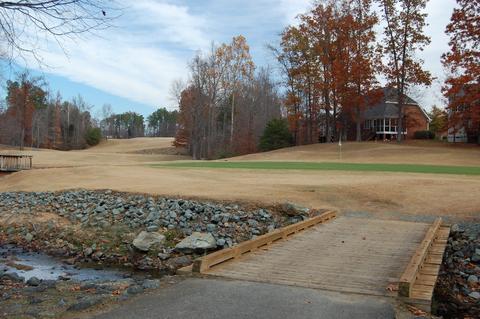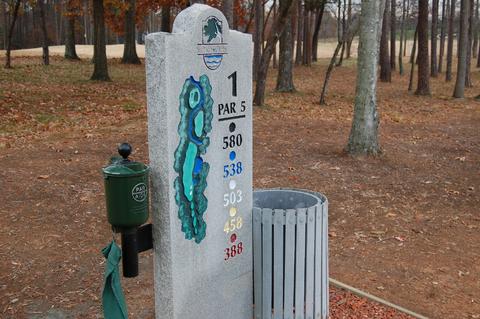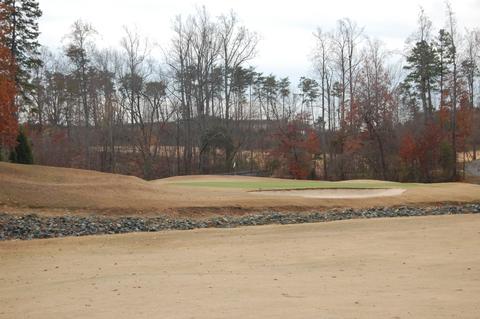
Looking back up the fairway from behind #1 at Stoney Creek, you see all the elements of an excellent starter, including the sloping landing area at mid fairway and the creek that gives the course its name and the hole its character.
In fine French restaurants, chefs often serve tiny little morsels called amuses bouche, meaning literally "a delight for the mouth." These bits are designed to get you off to a nice start on your meal and to hint at the chef's creativity and style.
The best golf course designers create amuses yeux, or delights for the eyes, at the first hole. They tend to ratchet back on the challenge, disinclined to punish the golfer lest the pleasant experience of the round begin on the first tee and end on the first green. First holes are rarely the most memorable of a round. For one thing, you play 17 holes after #1 and four hours later, details of the early holes are a little dim. Memorable holes on most courses are back loaded to leave you with a memory or give you something to talk about with your buddies at the 19th hole. Scan the photo galleries of the best courses in the world and you will find that the last three are generally the most photo-worthy.
A first hole has to indeed be special to be replayed in your head hours after your round. I played one such starter a few weeks ago at Stoney Creek in Whitsett, NC, while driving from Winston-Salem to Chapel Hill. Perhaps it was because I only played nine holes after a three-hour slog behind a few slow foursomes on the front nine, but I am confident that even after 18 I would have re-considered #1 on the Tom Jackson-designed course.
The first at Stoney Creek is a par 5 that plays to 538 yards from the "men's" tees. I am always happy to see a par 5 as the first hole since I rarely warm up on the practice range before a round, having been victimized too many times by leaving my best shots of the day there. So I welcome three shots to get to the first green, especially when the fairway is rather generous, as it is off the tee at Stoney Creek. What is unusual about this first hole is that the second shot is challenging for a first hole, played to a sloped landing area surrounded by the wide and very rocky Stoney Creek; I played my 3-iron rescue club successfully but not without some trepidation.
Creek; I played my 3-iron rescue club successfully but not without some trepidation.
The landing area is not huge, perhaps three or four times the size of a typical green, and it isn't by any means flat, so you do have to think carefully about placement in the middle of the area, rather than farther along where the fairway slopes down. A downhill lie just makes the approach shot back over the creek to the green more nerve wracking (I was able to negotiate an eight-iron to about 20 feet for a two-putt par). The creek branches off and surrounds the entire green. The only way to reach the amply sized putting surface is by one of three bridges. With the hazard in play for the second and third shots, the hole seemed more suited to a finisher than a starter.
As I look back on 2007, #1 at Stoney Creek was not the toughest hole I played all year or even the most visually attractive (a modern office building marred the view beyond the green). But it was certainly a candidate for #1 among the #1s. I hope the photos do it justice.



The tee shot at #1 at Stoney Creek (top) is fairly routine if you stay well enough left of the bunkers. The challenge is to keep your long-iron second shot from finding the downslope in the tight landing area (middle) before the tricky approach back over the creek to the large green (bottom).






 Creek; I played my 3-iron rescue club successfully but not without some trepidation.
Creek; I played my 3-iron rescue club successfully but not without some trepidation.






















